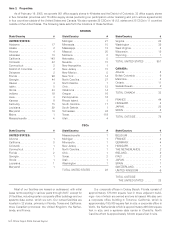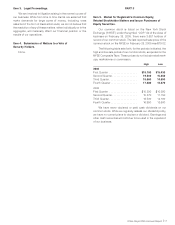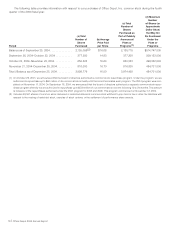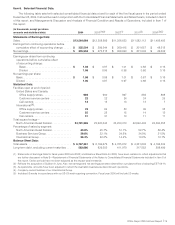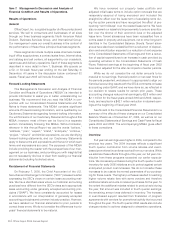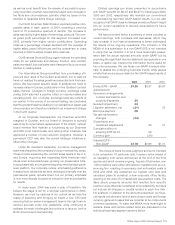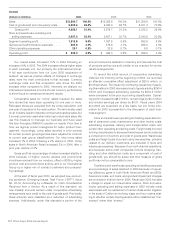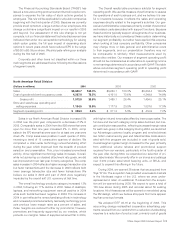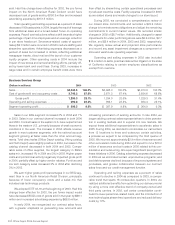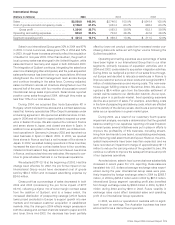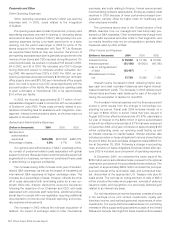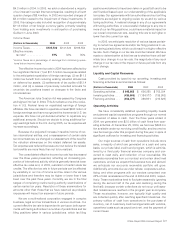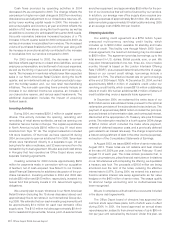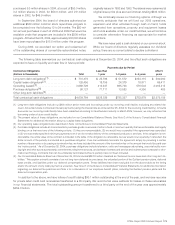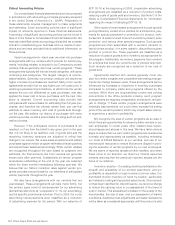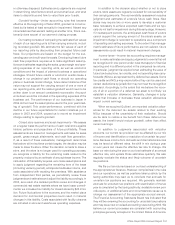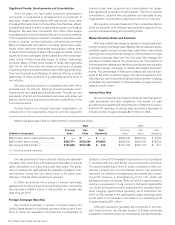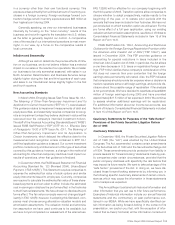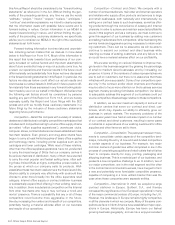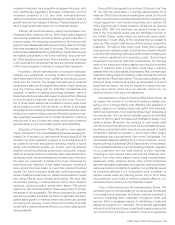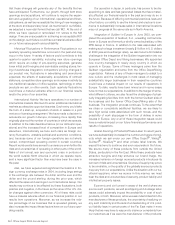Office Depot 2004 Annual Report Download - page 28
Download and view the complete annual report
Please find page 28 of the 2004 Office Depot annual report below. You can navigate through the pages in the report by either clicking on the pages listed below, or by using the keyword search tool below to find specific information within the annual report.
26 |Office Depot 2004 Annual Report
Corporate and Other
Other Operating Expenses
Other operating expenses primarily reflect pre-opening
expenses and, in 2003, costs related to the integration
of Guilbert.
Pre-opening expenses consist of personnel, property and
advertising expenses incurred in opening or relocating stores
and customer service centers (“CSCs”). We typically incur pre-
opening expenses during a six-week period prior to a store
opening, but the period was longer in 2004 for some of the
stores acquired in the transaction with Toys “R” Us. Because
we expense these items as they are incurred, the amount of
pre-opening expenses each year is generally proportional to the
number of new stores and CSCs opened during the period. On
a world-wide basis, we opened or relocated 103 stores in 2004,
64 in 2003, and 42 in 2002. We relocated one CSC in Europe
during 2004 and expect to complete another relocation dur-
ing 2005. We opened three CSCs in 2002. For 2004, our pre-
opening expenses were approximately $190,000 per domestic
office supply store and $75,000 per international office supply
store. Our cost to open a new CSC varies significantly with the
size and location of the facility. We estimate pre-opening costs
to open a domestic or international CSC to be approximately
$1.0 million per facility.
In 2003, we incurred approximately $17.7 million of non-
capitalizable integration costs in connection with our acquisition
of Guilbert in June 2003. These costs primarily related to pro-
fessional consulting fees for assistance with integration, man-
agement, internal communications plans, and human resource
aspects of the acquisition.
General and Administrative Expenses
(Dollars in thousands) 2004 2003 2002
General and
administrative
expenses . . . . . . . . . . $665,825 $578,840 $486,279
Percentage of sales . . . . 4.9% 4.7% 4.3%
Our general and administrative (“G&A”) expenses prima-
rily consist of personnel-related costs associated with global
support functions. Because these functions typically support all
segments of our business, we have not considered these costs
in determining our segment profitability.
The increase during 2004 includes a full year of Guilbert-
related G&A expenses, as well as the impact of translating all
international G&A expenses at higher exchange rates. The
increase as a percentage of sales, however, reflects the write
off of costs associated with terminating plans for a new cor-
porate office site, dispute resolutions, executive severance
following the departure of our Chairman and CEO, exit costs
associated with corporate staff reductions, additional profes-
sional fees to comply with new legislation requiring additional
documentation of controls over financial reporting, and corpo-
rate systems enhancements.
The increase in 2003 reflects the mid-year acquisition of
Guilbert, the impact of exchange rates on other international
expenses, and costs relating to finance, human resources and
merchandising software applications. Employee-related costs
declined in 2003 because of lower performance-based com-
pensation, partially offset by higher costs for healthcare and
other employee benefits.
The comments above and in the Overall section of this
MD&A describe how our management has historically pre-
sented our G&A expenses. Other companies may charge more
or less G&A expenses and other costs to their segments, and
our results therefore may not be comparable to similarly titled
measures used by other entities.
Other Income and Expense
(Dollars in thousands) 2004 2003 2002
Interest income. . . . . . . . $ 20,042 $ 14,196 $ 18,509
Interest expense. . . . . . . (61,108) (54,805) (46,195)
Loss on extinguishment
of debt . . . . . . . . . . . . (45,407) ——
Miscellaneous income,
net. . . . . . . . . . . . . . . . 17,729 15,392 7,183
Interest income increased in 2004, reflecting higher aver-
age cash and cash equivalent balances and higher interest-
based investment yields. The decrease in 2003 reflects lower
interest rates and lower cash balances for part of the year fol-
lowing the acquisition of Guilbert in mid-2003.
The increase in interest expense over the three-year period
ended in 2004 results from the change in borrowings out-
standing by period. Fiscal year 2004 includes interest on a
full year of $400 million in senior notes that were issued in
August 2003 at an effective interest rate of 5.87%, essentially a
full year of interest on the $250 million in senior subordinated
notes with an effective interest rate of 8.7% that were redeemed
in December 2004, a full year of interest on approximately $100
million outstanding under our revolving credit facility, as well
as interest expense on capital leases. Interest expense also
includes accretion on lease obligations for stores closed before
the end of 2002; the accrued lease obligations totaled $58.8 mil-
lion at December 25, 2004. Following a change in accounting
rules, accretion on lease obligations for stores closed after Jan-
uary 2003 is included as a component of operating expenses.
In December 2004, we redeemed the entire issue of the
$250 million senior subordinated notes, pursuant to the optional
redemption provisions of the subordinated notes indenture. The
payment of approximately $302 million included the principal,
accrued interest to the termination date, and contractual inter-
est, discounted at the appropriate U.S. Treasury rate plus 50
basis points. The net loss on extinguishment of debt of $45.4
million included the make whole payment, removal of deferred
issuance costs, and recognition of a previously deferred gain
related to an interest rate swap.
Our net miscellaneous income (expense) consists of equity
in the earnings of our joint venture investments, royalty and
franchise income, and realized gains and impairments of other
investments. Our equity-method investments are non-controlling
interests in office supply selling operations outside of the United
States and Canada. Earnings from these investments increased


